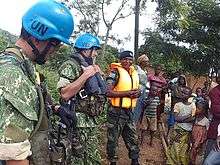Fizi Territory
Fizi is a territory in the south of Sud-Kivu Province, Democratic Republic of the Congo, bordering the South Kivu territories of Uvira, Mwenga and Shabunda to the north, Lake Tanganyika in the east, and the provinces Katanga in the south and Maniema in the west.
Fizi | |
|---|---|
 Fizi Location in Democratic Republic of the Congo | |
| Coordinates: 4°18′4″S 28°56′39″E | |
| Country | |
| Province | Sud-Kivu |
| Government | |
| • Territory Administrator | M. Aimé kawaya |
| Area | |
| • Total | 41,745 km2 (16,118 sq mi) |
| Population | |
| • Total | 1,000,674 |
| National language | Swahili |
| Climate | Aw |
The predominant language in the territory is bembe.
Geography
The Fizi territory is located in the south of the province, on the shore of Lake Tanganyika.
Administrative division
Collectivities within the Fizi territory include
- N'Gangya
- Lùlenge
- M'tambala
- Tangani'a
- Itombwe
Towns

The capital city (chef-lieu) of the Fizi territory is called Fizi Centre, but Baraka is considered the main town of the territory because of its semi-urbanized advancements. Baraka is composed of three municipalities (Baraka, Katanga and Kalundja). In 1892, it became the first entity in the urban model in the province of South Kivu.[1]
Some villages of Fizi are: Makobola, Kahama, Aseeci, Kwa Munene, Ilakala, Swima, Ake I, Ake II, Abeka, Mukwezi, Musenya, Atongo, Abûmbe, Ilela, Mgûle, Abondoki, Mboko, Lûûkyû, Mkangyaolo, Nundu, Bashiwaenge, Bashimweci, 'Yonwe, Zimbwe, Lusambo, Atûngulû, Atondo, Losenda, Lulinda, Elemyonga, Mkolwe, Bûkû, Bitobolo, Lûbûmba, Atete, Lweba, Andale, Ekwena, Abela, Alûnja, Looe, Matongo, Mwemezi, Bomani (Baraka centre), Ebonjwa, Mwansombo, Mwambango, Mongemonge, Mwatembo, Akyûngwe, Akomba, Atanga. Upon reaching Atanga, there is a junction, at which turning left leads to Fizi and the open side of the Lake Tanganyika shore. Malinde is a junction village. Towns after turning left include Malinde, Mlongwe, Atalûkûlû, Isee, Sebele. There is another junction in Sebele village. The right road leads to Eonde and then Kazimia village. The left road heads to Nemba, Msombozi, Kisokwe, Manga, Rasi, Mizimu, Kalongwe, Dine, Ibwe la nyookye, Kahongo, Equateur, Bandundu, Bas Zaire, Lubomo, Lwambama, Mwayenga, Kalila, Bwenge, Lubilo, Hona, Mwajalûlû, Bûma, Alamba, Kilumû, Kazimia.
There is no road access between Nemba to Kazimia; people use boats for transportation because most villages are built on shore and between mountains. Kazimia, Abumbwe, Nguma, Ekyoci, Lûandaki, Atuma, Ebamba, Ehingeci, Asaba, Msamba, Yungu, Esanu, Sele, Akone, Mkongwe, Mande, Talama and the river Alela is the border of Fizi and Shaba or Sud-Kivu province and Shaba Province.
History
The region has a long history of independence from Kinshasa. It was the location of the maquis set up by Laurent-Désiré Kabila in 1967,[2] as well as the place where Laurent-Désiré Kabila raised his son, the current President Joseph Kabila, in 1973. Throughout much of the Second Congo War, the town was contested by numerous armed groups.[3]
Politics
The Fizi territory is represented in the National Assembly by three deputies:
- Amy Ambatobe (UDPS/TSHISEKEDI)
- Celestin Anzuluni (Ind)
- Jean Kevin Jemsi (PANADER)
Notes and references
- Radio Okapi, accessed September 2009
- "Anatomy & History of the Zaire-Congo Crises" Archived 2007-10-10 at the Wayback Machine by Georges Nzongola-Ntalaja, usafricaonline.com, 19 November 1996
- "Background Brief on the Current Situation in Kivu" Archived 2007-08-06 at the Wayback Machine, IRIN, 10 September 1997 (hosted by africaaction.org); "Thousands of civilians victims of atrocities in the DRC" Archived 2006-08-31 at the Wayback Machine, Amnesty International, 23 November 1998; and "DR Congo: Complex Emergency Situation Report #4 (FY 2004)", United States Agency for International Development, 20 August 2004 (hosted by reliefweb.int)
External links
- Territoire de Fizi-Itombwe ou le pays de Babembe, fizi-itombwe.com (in French)
- Rapport de l'Atelier de Réflexion sur les Resources Locales et la Dynamique du Développement Rural dans le Territoire de Fizi - Itombwe, report of seminar held 19–21 February 2006 (in French)